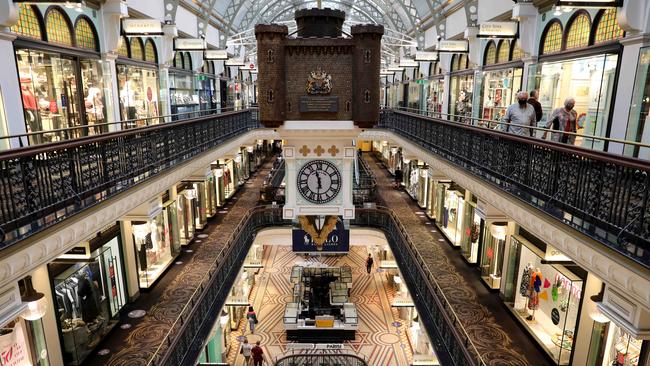
It is history speaking. Holding out its hand to us as a community. For these buildings open up worlds in our imagination. Connect us to our forebears and their distant but oddly similar lives. These buildings are enjoyed for their splendour and beauty and their little quirks of architectural loveliness and the sheer wonder of what they were – and still are.
And so to a tiny, personal heart flinch of a moment. During a meandering day of soaring blue skies and sparkling harbour I roamed Sydney’s CBD, ending up in Pitt St Mall for the first time in more than a year. And within that bustling thoroughfare I realised that a historic façade had been drastically altered.
The iconic Soul Pattinson building had tenaciously clung to its prime retail spot for almost 150 years as nondescript glassy towers soared higher and higher all about it. That stubborn little Victorian Italianate building had endured, miraculously. Coltish, slender iron pillars held up that old staple of Australian retail life, the awning, which jutted into the mall with a lovely lightness. There were scrolls of iron lace and snatches of old-style lettering and the building sang to my heart whenever I saw it; that it still existed as it extended a hand from its past into the future and clung on.
It had contained wonders over the years: a “Ladies Department” run by a nurse, an American-style soda fountain that survived until 1948. The striving for beauty in the detail – to connect, please, delight – felt deeply human. The charming façade was like an accommodating dialogue with the past, Chinese whispers of a more refined time, and it had been cherished over the generations. There was love in that structure.
The building was bought for more than $100 million a few years back; the site is now occupied by a multinational cosmetics company and the beauty of the old entrance has vanished. The coltish pillars and iron lace are all gone. I gasped in shock when I saw it. The construction company behind the makeover says that compliance with the heritage laws was of “utmost importance” but, to me, all the charm of the entrance façade has been stripped away. It feels like an affront to history.
“That’s life what’s revealed,” said archaeologist Basil Brown, a character in the recent film The Dig, about the discovery of the buried Anglo-Saxon ship at Sutton Hoo in England. “They’re like emissaries from another world!” it was declared as the ship’s golden treasures were unearthed. “From the first human handprint on a cave wall, we’re part of something continuous.”
As I stared at my made-over Soul Pattinson building, mouth agape and bereft, I felt the sting of desecration. Wondered what on earth the traditional owners of Western Australia’s sacred Juukan Caves must have felt when they heard that Rio Tinto had blown up their own emissaries from the past; that had made them feel they were part of something continuous. Here I was, devastated at 140-odd years of history being altered, yet they had had 46,000 years of history, and now it was rubble. For thousands of years the wonder of those caves had endured and now they were gone. The audacity, the bullish arrogance, the thoughtlessness. For what? Shortsighted greed. Always, dispiritingly, that.




Do the owners of the beautiful old buildings threaded through our daily lives, in both the domestic and public spheres, have any idea of the magical hold these structures sometimes hold over us; we who are utter strangers, mere passers-by in the rush of life? These places are often freighted with a meaning that is richer and deeper than the scope of a building’s purpose. They are viewed as precious and singular and cherished, by a collective. By the many strangers who pause before the wonder of these grand old buildings, and take note, and silently tip their hats to the past.